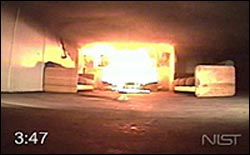Sprinklers shown effective in slowing dorm fires

Photo of a NIST experiment in a dorm day room without sprinklers 3 minutes and 47 seconds after a fire was ignited.
An automatic sprinkler system significantly increases a person’s chances of surviving a dormitory fire, according to a report issued recently by the National Institute of Standards and Technology (NIST).
Three NIST experiments,* supported by a U.S. Fire Administration (USFA) initiative for fire safety in college housing, compared the hazards of fires in smoke detector-equipped dormitories with and without fire sprinklers in the room of fire origin. Researchers started fires in a day room or lounge area open to the corridor of a dormitory. They used the temperature of 120 degrees C (248 degrees F) as the cutoff mark for human survival. For comparison, the temperature of boiling water is 100 degrees C.
In two experiments without sprinklers, potentially fatal temperatures exceeding 120 degrees C as well as toxic gases reached a remote corridor 22.9 meters (75 feet) away within three minutes and completely spread throughout the corridor within another three minutes. In an experiment with sprinklers, temperatures at the 1.5 meter (five feet) level and below in the room where the fire began never exceeded 120 degrees C. No significant increase in heat was measured in the corridor during the experiment, allowing adequate time for residents to escape.
NIST conducted the experiments at a barracks donated by the Myrtle Beach Air Force Base Redevelopment Authority in Myrtle Beach, S.C. The USFA incorporated footage of NIST sprinkler tests into a fire safety video for college administrators and students.
Media Contact
More Information:
http://www.nist.govAll latest news from the category: Architecture and Construction
Newest articles

Sea slugs inspire highly stretchable biomedical sensor
USC Viterbi School of Engineering researcher Hangbo Zhao presents findings on highly stretchable and customizable microneedles for application in fields including neuroscience, tissue engineering, and wearable bioelectronics. The revolution in…

Twisting and binding matter waves with photons in a cavity
Precisely measuring the energy states of individual atoms has been a historical challenge for physicists due to atomic recoil. When an atom interacts with a photon, the atom “recoils” in…

Nanotubes, nanoparticles, and antibodies detect tiny amounts of fentanyl
New sensor is six orders of magnitude more sensitive than the next best thing. A research team at Pitt led by Alexander Star, a chemistry professor in the Kenneth P. Dietrich…





















